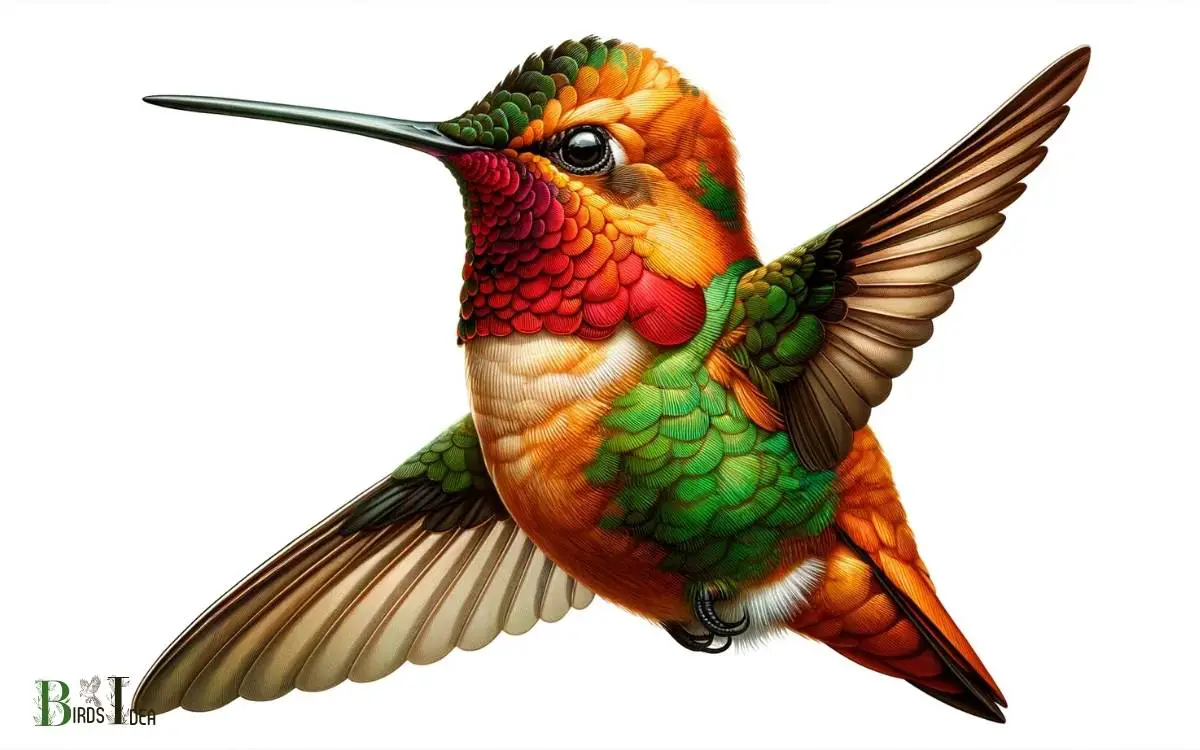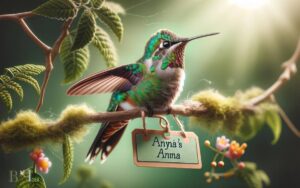What Does a Rufous Hummingbird Look Like? Explain!
The Rufous Hummingbird (Selasphorus rufus) is a small bird known for its striking appearance.
Males have a bright orange-brown body, often referred to as rufous, with a white breast and an iridescent red throat patch, or gorget, which can appear dark when not in good light.
Females are less vibrant, with green upperparts, white underparts, and speckled throats.
They both have slender, straight bills and rapid, darting flight patterns typical of hummingbirds.
The Rufous Hummingbird is a species admired by birdwatchers due to its fiery coloration and dynamic behavior. It is one of the smaller members of the hummingbird family, measuring only about 3 inches in length.
Its size and agility allow it to navigate through dense foliage and feed on nectar from a variety of flowers. They are territorial and often seen chasing away intruders, including other hummingbirds.
The Rufous Hummingbird has a vast migratory pattern, traveling up to 4,000 miles from its wintering grounds in Mexico to breeding habitats as far north as Alaska.
The Rufous Hummingbird’s remarkable migration is one of the longest of any bird in relation to its body size, a testament to its endurance and adaptability.

Key Takeaway
Physical Description
The Rufous Hummingbird’s physical description includes a vibrant orange-red plumage. Their coloring is particularly striking in the males, while females have green and orange feathers.
These tiny birds are about 3 to 3.5 inches in length, with a wingspan of 4 to 4.5 inches. Their small size and remarkable agility allow them to hover and dart with incredible speed.
The male’s throat is adorned with an iridescent orange-red patch, known as a gorget, which glows like embers in the sunlight.
Their slender, slightly down-curved bill is perfectly adapted for reaching nectar deep within flowers.
Rufous Hummingbirds also have white breast feathers and green back feathers, creating a beautiful contrast with their fiery orange-red plumage.
Plumage and Colors
With vibrant orange-red plumage and iridescent throat patches, the Rufous Hummingbird displays striking colors in both males and females.
The male Rufous Hummingbird is known for its vibrant orange-red throat and sides, while the back and tail feathers are a mix of green, rufous, and orange.
The female, on the other hand, has green and orange feathers on the back and tail, with a speckled throat featuring orange and red spots.
Below is a summary of the plumage colors for both male and female Rufous Hummingbirds:
| Body Part | Male Colors | Female Colors |
|---|---|---|
| Throat | Vibrant orange-red | Speckled orange-red |
| Back & Tail | Green, rufous, and orange | Green and orange |
These vivid colors make the Rufous Hummingbird a delight to observe in their natural habitat.
Size and Shape
Displaying a compact and streamlined physique, the Rufous Hummingbird is known for its diminutive size and distinctive shape.
Measuring only 3-4 inches in length, this bird is often described as petite and dainty. Its slender, slightly curved bill is perfectly adapted for reaching into flowers to feed on nectar, while its wings are long and tapered, allowing for agile and rapid flight.
The Rufous Hummingbird’s body is characterized by a sleek and aerodynamic build, with a short neck and a squared-off tail. These features contribute to its remarkable maneuverability and swift aerial movements.
Despite its small size, the Rufous Hummingbird’s unique shape and proportions make it a formidable and captivating sight in the avian world.
Unique Features
Characterized by its iridescent plumage, the Rufous Hummingbird possesses unique features that distinguish it from other hummingbird species.
This tiny bird, known for its agility and territorial nature, has several distinctive characteristics.
Here are some of the key unique features of the Rufous Hummingbird:
| Unique Feature | Description |
|---|---|
| Brilliant Plumage | Males exhibit vibrant orange-red plumage, while females display green and orange hues. |
| Territorial Behavior | Rufous Hummingbirds are fiercely territorial and will vigorously defend feeding areas. |
| Long Migration | Despite their small size, they undertake one of the longest migratory journeys of any bird. |
| High Metabolism | With a heart rate reaching up to 1,260 beats per minute, they have an incredibly high metabolism. |
These features set the Rufous Hummingbird apart, making it a fascinating and unique species within the hummingbird family.
Molt and Variation
The molt and variation of the Rufous Hummingbird’s plumage reveal interesting insights into its seasonal changes and individual differences.
In addition to its unique features, the molt and variation of the Rufous Hummingbird’s plumage provide further characteristics that distinguish this species within the hummingbird family.
- Seasonal Changes: The Rufous Hummingbird undergoes a complete molt before migration, replacing all of its feathers, which results in variations in its plumage color and patterns.
- Sexual Dimorphism: Male and female Rufous Hummingbirds display distinct plumage variations. Males typically have vibrant orange-red throats and white underparts, while females exhibit green backs and rusty, speckled throats.
- Age-related Variation: Juvenile Rufous Hummingbirds have plumage that differs from adults, with duller colors and less defined markings.
- Individual Differences: Some Rufous Hummingbirds may exhibit unique variations in plumage, such as unusual color patterns or aberrant markings.
Gender Differences
Male Rufous Hummingbirds are easily distinguished by their vibrant orange-red throats and white underparts, while females exhibit green backs and rusty, speckled throats. This sexual dimorphism is one of the most notable features of Rufous Hummingbirds.
The bright colors of the males serve to attract females during the breeding season, while the more muted tones of the females provide better camouflage for nesting and protecting their young.
The distinct visual differences between the sexes play a crucial role in their reproductive behaviors and survival strategies.
It is important for birdwatchers and researchers to be able to identify these gender disparities, as it aids in the understanding of their behaviors, ecological roles, and population dynamics.
Recognizing these gender differences is also essential for conservation efforts aimed at preserving this captivating species.
Conclusion
The rufous hummingbird is a stunning bird with vibrant plumage and a small, delicate shape. Its fiery orange coloring and iridescent green feathers make it a truly magnificent sight to behold.
The unique features of this bird, such as its long, slender bill and rapid wing beats, set it apart from other species.
Overall, the rufous hummingbird is a remarkable creature that captivates all who have the privilege of observing it in the wild.






